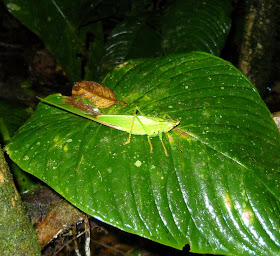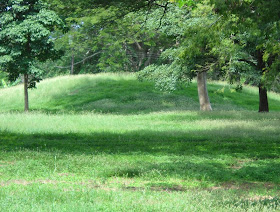We arrived in Panama City (huge, hectic, skyscrapery place) and got the heck outta dodge the next day. We headed to El Cope, the teeny town in the mountains where Chad did his postdoc years ago and where his class will be based.


There is electricity but no internet in El Cope, although that will change before the class arrives. In either of the two restaurants in town, lunch is $1.50 and dinner was somewhat steep at $1.75. We stayed with Chad's friend Julie Ray who lives in El Cope along with her dog Lucy, who enjoyed a downward dog session with me.
Julie is building La Mica Biological Station there. The station is currently under construction, and is situated in a beautiful spot along a small river in El Cope.

Chad pointed out that next to the river, four plants my mom has in her house were growing in one square meter:
Julie at the cabin at la Mica:
The dorm foundation:
Chad's class will stay in this dorm from Feb through April, doing research on anything from frogs to farms and taking classes along the way. They will also venture out into other areas of Panama for trips of varying lengths, including a five day stay in the town of Marta. This town is at the end of a long road only accessible by 4WD in dry conditions (or walking in wet conditions).
 The students will be staying at the electricity-free homes of the town's residents, eating meals with them, interviewing them, working in the community, and improving their Spanish.
The students will be staying at the electricity-free homes of the town's residents, eating meals with them, interviewing them, working in the community, and improving their Spanish.
They will also make a long hike from Marta to a plane wreckage way up in the mountains. This is where Omar Torrijos, the leader of Panama in the 70's until his death in 1981, met his death when his plane crashed under sketchy assassinationy circumstances. Although a U.S. Special Forces team recovered his body, the local people believe that he actually survived the crash and lives in the jungle near the crash site.
Even the school is called Omar Lives.


The kids were excited to see their photos on my digital camera after I took them. Allegedly none of the families even own any print photos of their kids!
Like other nearby towns, the mandarin orange is an important crop so there are orange trees everywhere, a familiar sight to me in California. But here the trees are also covered in air plants.
Then it was back to El Cope to go for a night hike in Omar Torrijos National Park, where Chad did his postdoctoral work on the effect of the amphibian decline on snake populations. Up until a few years ago this place was CRAWLING with ectothermic creatures of all kinds. Then the montane frogs in Panama, like many other places in the world, were crushed by an epidemic of chytridiomycosis, a fatal syndrome caused by a fungus. With no frogs to eat, the starving snakes ate all the lizards, and then finally died out, so now there isn't much at all in the way of frogs, lizards, and snakes. It was a beautiful place, but eerily "dead" for such a lush forest. We did manage to see a few frogs:
Katydid:

Vine snake:
An awesome phasmid (so-called because we watched Master and Commander a few days later, and the name stuck):
This snail-eating snake was on the road next to Julie's house:
The next day we went to El Cano, an active archaeological dig site.
There are large burial mounds all over this site, full of bodies from before 1500.

One site is excavated and on display to the public:

A gringo archaeologist looted the site in the 1920's, tearing intricate stone carvings from pillars such that this is all that's left (the carvings are on display in a museum in New York):
There is a museum there that some of Chad's students will work at:
They will also help with the active dig (nothing going on this time of year because it's so rainy, but in spring it will be back on):
Next we went back up to the mountains to a town in a volcano called El Valle de Anton. I had a 24-hour bug that day and missed most of the fun including the beautiful scenery on the drive up there. I slept the day away and the next day we visited the El Valle Amphibian Conservation Center (EVACC), a frog conservation center run by Edgardo and Heidi (who Chad knows from his postdoc days in Panama). The area is famous for its populations of the golden frog, which thanks to the chytrid fungus can now best be viewed in tanks inside EVACC. This center is doing some really important work and has some great stuff. You can read more about Panama's amphibian declines and conservation efforts here. Here's the public golden frog display:
And some others:
We also got a behind the scenes tour from Heidi:


Here are the golden frogs (gorgeous!):
After El Valle it was off to the beach for a very non-gringoy Thanksgiving at the fabulous Playa Blanca Beach Resort, complete with said white sand beaches:
And even some water aerobics in one of the two giant pools:
Then it was back to Panama City for a shoporama prior to departure back to the states. I found New Moon in Spanish on the eve of the movie's release.
But the real treasures were at an artisan market that used to be the YMCA in the Canal Zone. Check out the baskets:
The molas made by the Kuna Yala:
And the tagua nut carvings!
Overall, I was struck by how different Panama was from the other central American countries I have visited. Different in small ways (lentils instead of black beans) and big ways (the riches in city compared to the poverty of the country). Very few people speak English there, so I was thinking in Spanish for a few days upon my return. I had a great time and can't wait to return for spring break in March.
Oh, one more thing. The cigarette warning labels in Panama are awesome!




Did you see the suffering smoker visage in the hourglass? But my favorite is still the dead rat and cucaracha.

1) i *LOVE* the cigarette packs, 2) give me THAT water aerobics instructor anyday, and 3) the hottie quotient explodes sans vello facial. cool trip, great pics, and gorgeous smiles. bravo.
ReplyDeleteWhen I went to Panana, I saw to many poor people living in the street. I think you should talk about it, they are more important than a snake or a river.
ReplyDeleteNice bblog
ReplyDelete